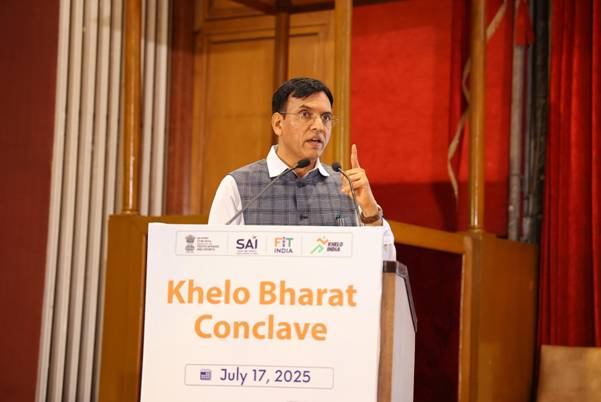Dr. Mansukh Mandaviya Unveils Olympic Top-10 Strategy at Khelo Bharat Conclave 2025
Dr. Mandaviya described the policy as “an ambitious yet achievable blueprint” rooted in ground realities and backed by structured planning.

- Country:
- India
New Delhi | July 18, 2025 — In a major move to transform India into a global sporting superpower, Union Minister for Youth Affairs and Sports, Dr. Mansukh Mandaviya, unveiled a bold vision to position India among the top 10 nations in the 2036 Summer Olympics and Paralympics. This announcement came during the Khelo Bharat Conclave, a high-profile gathering of India’s sports leadership ecosystem aimed at defining the strategic direction for Indian sports under the newly launched Khelo Bharat Niti 2025.
Held in New Delhi, the conclave was attended by delegates from the Indian Olympic Association (IOA), Paralympic Committee of India (PCI), National Sports Federations (NSFs), state sports ministries, corporate leaders, sports institutions, and members of civil society. Over the course of six hours, participants engaged in extensive deliberations on the roadmap to Olympic success and long-term sporting excellence leading up to India@2047.
From Vision to Action: The Khelo Bharat Niti 2025
At the heart of the conclave was the Khelo Bharat Niti 2025, India’s integrated sports policy focused on:
-
Grassroots talent identification
-
Elite athlete development
-
Infrastructure expansion
-
Sports education and training
-
Governance reforms and accountability
Dr. Mandaviya described the policy as “an ambitious yet achievable blueprint” rooted in ground realities and backed by structured planning. “Sports is a public movement,” he said. “We need collective effort, good governance, and an unwavering focus on execution to achieve our goals.”
He emphasized that under Prime Minister Narendra Modi’s vision, sport is not just for medals but for nation-building, youth empowerment, and economic growth.
Key Pillars of India’s Olympic Strategy
-
Governance and Accountability
-
The upcoming National Sports Governance Bill, set to be tabled in the Monsoon Session of Parliament starting July 21, will usher in a transparent, performance-based regulatory framework for NSFs and other sports bodies.
-
Dr. Mandaviya urged all NSFs to submit a five-year strategic roadmap by August 2025, followed by a decade-long action plan to align with Olympic ambitions.
-
-
Performance-Based Funding
-
Going forward, government grants to sports federations will be linked to performance metrics, including athlete outcomes, infrastructure utilisation, and coach deployment.
-
-
Talent Pyramid and Olympic Training Centres
-
A three-tiered talent development model will anchor future sports development:
-
Level 1: Residential Sports Schools (grassroots)
-
Level 2: Intermediate Centers (state and regional)
-
Level 3: Olympic Training Centres (elite performance)
-
-
This pyramid aims to seamlessly identify, nurture, and elevate talent from school-level competitions to international podiums.
-
-
‘One Corporate One Sport’ Initiative
-
Encouraging private sector participation, the initiative calls for each corporate house to adopt a sport, support its athletes, and develop infrastructure. This aims to build a sustainable sports economy.
-
-
Anti-Doping and Ethics
-
Acknowledging doping as a serious concern, the conclave addressed the need for robust anti-doping education, transparent testing mechanisms, and international collaboration for clean sport.
-
States, Coaches, and Calendar Discipline
The Minister underscored the pivotal role of States in realising India’s Olympic dream. The Ministry of Youth Affairs and Sports (MYAS) plans to sign collaborative agreements with state governments, schools, and corporates to decentralize and institutionalise sports development.
He also highlighted the shortage of qualified coaches and administrators, and called for the establishment of training academies for coaches, sports scientists, and managers.
To improve athlete experience, NSFs were directed to maintain a centralised calendar of national and international events, to avoid scheduling conflicts and logistical hurdles.
Stakeholder Response and Policy Endorsement
Union Minister of State for Sports, Smt. Raksha Nikhil Khadse, noted that the Khelo Bharat Niti was a product of over a year of consultations and revisions. She acknowledged the contributions of various stakeholders in shaping a policy that is visionary, inclusive, and grounded in challenges faced by Indian athletes.
“This is not just about medals. It’s about using sport to generate employment, boost India’s soft power, and channel youth energy productively,” said Smt. Khadse.
Each presentation — on sports governance, Olympic medal roadmap, corporate partnerships, and Khelo Bharat implementation — was followed by interactive feedback sessions, with suggestions recorded by senior ministry officials for policy refinement.
From Sports to Soft Power: Looking Ahead to India@2047
Dr. Mandaviya concluded the conclave with a rousing call to action. “The dream of finishing among the top 10 nations in the 2036 Olympics is realistic if we begin today with clarity, unity, and resolve. Sport can be India’s next big soft power, a global invitation for the world to compete, train, and celebrate in India.”
The roadmap stretches far beyond medals. By 2047, the government envisions:
-
A globally competitive sporting infrastructure
-
Thousands of trained professionals in sports careers
-
Robust sports tourism and entertainment industries
-
India as a host of major international events, including potentially the Olympic Games
- READ MORE ON:
- Khelo Bharat Niti 2025
- India Olympics 2036
- Mansukh Mandaviya
- Sports Governance Bill
- NSFs
- Olympic Training Centres
- Corporate Sports Support
- Sports Infrastructure
- Indian Olympic Association
- Raksha Khadse
- Youth Affairs and Sports Ministry
- India@2047
- Sports Policy India
- Sports Talent Pyramid










